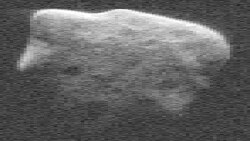The big space headlines recently have been about the asteroid 2016 QA2, how close it came to Earth and how it was discovered just a few hours before its fly-by.
The media were a bit emphatic in their concern. "Earth Just Narrowly Missed Getting Hit by an Asteroid," was the headline in Popular Mechanics, and a close match for other media reaction to QA2's close shave.
Perspective is important
Keeping an eye on the skies isn't a new hobby. NASA has been doing it since 1998, when the Near-Earth Object (NEO) Program Office was established at the Jet Propulsion Laboratory to "coordinate NASA-sponsored efforts to detect, track and characterize potentially hazardous asteroids and comets that could approach the Earth." And less than a year ago, the space agency formalized the program, naming it the Planetary Defense Coordination Office (PDCO).
It's a matter of record that we've been pounded by our share of space rocks over the millennia. One of the most recent was the meteor of 2013 that came roaring into the atmosphere at 18 kilometers a second and exploded 22 kilometers above the Russian town of Chelyabinsk.
It carried the force of 30 of the atomic bombs that leveled Hiroshima, Japan, in World War II. The shock wave terrified the locals, and more than 1,000 people were treated for injuries caused primarily by windows blown in by the force of the blast.
This safely qualified as a space boulder, fully 18 meters across, but just to give a sense of scale, the Chicxulub asteroid that likely ended the reign of the dinosaurs was 10 kilometers across.
2016 QA2 runs an estimated 15 to 45 meters in size. But if a meteor that big hit Earth's atmosphere, it could cause some serious damage to a populated area.
But asteroids are a fact of life on Earth. NASA estimates that about 100 tons of "stuff" rockets into our atmosphere every day — everything from dust to gravel to rocks — and the only impression they makes on us is if we look up into the sky on a clear night and make wishes on the ones that burn up in the atmosphere.
But, it is a thing
But if there was "nothing" to worry about, NASA wouldn't have a Planetary Defense Program. The space agency has discovered more than 14,000 Near-Earth Objects (NEOs) buzzing around in space. Of those, almost 900 have a diameter of one kilometer or more. Asteroids that size would do significant damage if they hit Earth.
Nearly 4,000 other NEOs on NASA's radar have a diameter of 300 to 1,000 meters. These could do significant local damage, and create potentially deadly tsunamis if they hit the ocean. And they do enter our atmosphere. About 100 years ago, an asteroid exploded in the air above the mostly uninhabited Tunguska region in eastern Siberia and flattened trees in a 2,000-kilometer area. That rock was 36 meters across.
If that same meteorite had struck in a metropolitan area, former NASA astronaut Ed Lu told Congress in 2013, it could destroy "an area roughly the size of metropolitan Washington, D.C."
So, it's in our best interest to keep a watchful eye on the NEOs. Next week, NASA is scheduled to launch the OSIRIS-REx mission that will visit one the of biggest Near-Earth Objects — an asteroid called Bennu. It has a reasonably high probability of hitting our planet sometime in the 22nd century.
At nearly 500 meters in diameter, it's one of the larger NEOs out there. NASA is hoping the OSIRIS-REx flight will gather enough information about Bennu, and asteroids in general, to help plan for how to deal with them in the future.
Is there a plan?
So, what happens if we find a dangerous asteroid on a collision course? There's no coordinated strategy at the moment, but there are two real options: Blow it up way out in space, or get people out of the way. Both options are possible.
NASA and the Federal Emergency Management Agency (FEMA) are gaming out ways to do both. The United Nations has recommendations on the table to create worldwide warning networks and advisory groups to plan for what is, ultimately, the inevitability of something big hitting the Earth.
And NASA is moving forward with something it calls the Asteroid Redirect Mission (ARM). The goal is to "move" a multi-ton boulder headed to Earth into a safe orbit around the moon, and they're planning this project for the 2020s.
When all is said and done, getting killed by an asteroid is incredibly unlikely. Keep in mind that not a single human has been killed by an asteroid in all of recorded human history. And according to NASA, "no large object is likely to strike the Earth any time in the next several hundred years." So, relax, go outside and wish on a falling star; don't worry about one.









